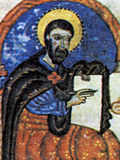Movses Kaghankatvatsi
You can help expand this article with text translated from the corresponding article in Armenian. (March 2020) Click [show] for important translation instructions.
|
Movses Kaghankatvatsi (Old Armenian: Մովսէս Կաղանկատուացի Movsēs Kałankatuac῾i 'Moses of Kaghankatuk'), or Movses Daskhurantsi (Մովսէս Դասխուրանցի Movsēs Dasxuranc῾i 'Moses of Daskhuran), is the reputed author (or the alias of several authors) of a tenth-century Classical Armenian historical work on Caucasian Albania and the eastern provinces of Armenia, known as The History of the Country of Albania (Պատմութիւն Աղուանից Աշխարհի, Patmutʿiwn Ałuanicʿ Ašxarhi).[1][2][3][4]
Authorship
The first historian to mention Movses' work was the medieval Armenian legal scholar Mkhitar Gosh, referring to him as "Movses Daskhurantsi."[5] A later historian, Kirakos Gandzaketsi, referred to a statement in the History itself, to attribute the name of the author as Movses Kaghankatvatsi. The statement in question (Book II, ch. 11) says:
When the enemy became aware of what had happened, they pursued them and overtook a group of them at the foot of the mountain opposite the large village of Kaghankatuik, which is in the same province of Uti where I too am from.
Movses narrates the Khazar invasion of Transcaucasia and other events up to the seventh century in Book I and II of his History. Book III of his History differs from the previous ones in style of writing[6] and date. It deals with the Caspian expeditions of the Rus' and their conquest of Partav in the tenth century. Because of such time lapse and difference in style, attribution of the work to a single author seems doubtful. For this reason it has been common to assume two consecutive authors or editors, Kaghankatvatsi (seventh century) as the author of Books I and II, and Daskhurantsi (tenth century) as the editors of Kaghankatvatsi's text and the author of Book III.[5]
Publications and translations
Grabar (Old Armenian)
- Movsēs Kaghankatuatsʻi (1860). Patmutʻiwn Aghuanitsʻ ashkharhi Պատմութիւն Աղուանից աշխարհի (PDF). Moscow: Tp. Lazarean chemarani Arewelean lezuatsʻ. Published by N. Emin.
- Movsēs Kaghankatuatsʻi (1860). Patmutʻiwn Aghuanitsʻ Պատմութիւն Աղուանից. 2 vols. Paris: Tp. Karapet Shahnazarean. (Vol. 1, vol. 2.)
- Movsēs Kaghankatuatsʻi (1912). Patmutʻiwn Aghuanitsʻ ashkharhi Պատմութիւն Աղուանից աշխարհի (PDF). Tiflis: Tparan ōr. N. Aghanean. A reprint of the 1860 Moscow edition.
- Movsēs Kaghankatuatsʻi (1983). Patmutʻiwn Aghuanitsʻ ashkharhi Պատմութիւն Աղուանից աշխարհի. Critical text and introduction by Varag Arakelian. Erevan: HSSH GA hratarakchutʻyun.
Modern Armenian
- Movses Kaghankatvatsʻi (1969). Patmutʻyun Aghvanitsʻ ashkharhi Պատմություն Աղվանից աշխարհի. Translated by Varag Arakelian. "Hayastan" hratarakchʻutʻyun.
Russian translations
- Istorīia Agvan Moĭseia Kagankatvatsi, pisatelia X vieka Исторія Агванъ Мойсея Каганкатваци, писателя X вѣка. Translated by K. Patkanov. Saint Petersburg: Tip. Imp. Akad. nauk. 1861.
{{cite book}}: CS1 maint: others (link) - Movses Kalankatuatsi (1984). Istoriia strany Aluank История страны Алуанк. Translated by Sh. V. Smbatian. Erevan: Matenadaran.
Georgian translation
- Movses K'alank'at'uatsi (1985). Alvanta kveq'nis ist'oria ალვანთა ქვეყნის ისტორია (PDF). Translated by L. Davlianidze-Tatishvili. Tbilisi: Metsniereba.
English translations
- Movsēs Dasxuranc̣i (1961). The History of the Caucasian Albanians. London Oriental Series, Vol. 8. Translated C. J. F. Dowsett. London: Oxford University Press.
- Movsēs Dasxuranc'i (2010). The History of the Aghuans. Sources of the Armenian Tradition. Translated by Robert Bedrosian. Long Branch, New Jersey.
{{cite book}}: CS1 maint: location missing publisher (link)
References
- ^ Kushnareva, Karinė Khristoforovna (1997). H. N. Michael (trans) (ed.). The Southern Caucasus in Prehistory. Univ. of Pennsylvania. p. 196. ISBN 0-924171-50-2.
The tenth century A.D. Armenian historian Movses Kalankatuatsi states that ...
- ^ (in German) Gesellschaft, Görres. Oriens Christianus. Leipzig, Germany: O. Harrassowitz 1905, p. 274
- ^ Bosworth, C. E. (1986). "Arrān". In Yarshater, Ehsan (ed.). Encyclopædia Iranica, Online Edition. Encyclopædia Iranica Foundation.
- ^ Howard-Johnston, James D. (2006). East Rome, Sasanian Persia and the End of Antiquity. Ashgate Publishing, Ltd. p. 49. ISBN 0-86078-992-6.
- ^ a b Hacikyan, Agop Jack (2000). The Heritage of Armenian Literature. Wayne State University Press. pp. 171–172, 364. ISBN 0-8143-3023-1.
- ^ Hewsen, Robert H. (1964). Notes and Communications. London: Bulletin of Oriental and African Studies, University of London vol. 27. pp. 151–156.

